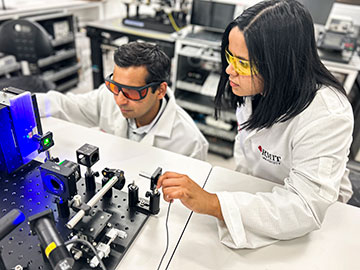
The neuromorphic vision chip developed by the international group of researchers. [Image: RMIT University]
Together, the human eye and brain process information more efficiently than any current machines—so scientists look to the human vision system as a paradigm for designing artificial systems that capture and process images.
A research group recently designed a neuromorphic vision chip that can reportedly “see” in the ultraviolet range and rapidly process the detected images (Adv. Funct. Mater., doi: 10.1002/adfm.202303641). The new device uses nanoscale-thin semiconductor wafers that exhibit persistent photoconductivity—the ability to conduct electric signals for a period after the stimulating light is gone. The effect mimics postsynaptic current within the brain. The researchers say their work could lead to machine-vision systems that can make rapid decisions for autonomous driving or inspections on the manufacturing floor.
The key: ultrathin layers
Many machine-vision systems require relatively strong changes in photocurrent to reach the current threshold needed for learning processes to work properly. This requirement slows the rate at which images are detected and raises the amount of energy the device needs to operate.
The sensor–processor designed by Sumeet Walia and Aishani Mazumder at RMIT University and their colleagues addresses these issues by using antimony-doped indium oxide sheets less than 3 nm thick. These sheets, with a driving voltage of 50 mV, were exposed to 285-nm-wavelength LED light to study the material’s response.

Professor Sumeet Walia (left) and Ph.D. student Aishani Mazumder, both of RMIT University, Australia, perform a demonstration (using visible light) of the experimental setup for their neuromorphic vision research that used ultraviolet light. [Image: W. Wright, RMIT University]
Doping the In2O3 sheets with antimony allowed the team “to engineer a very slow decay rate of photocurrent once the visual stimulus is removed,” Walia says. “This slow decay rate allows for longer term storage of information and to retain information for longer without the need for frequent training cycles or rehearsals.”
According to Walia, the persistent photoconductivity significantly reduces the device’s energy consumption and allows the device to process information in the sensor itself—mimicking neural synaptic behavior. It also resulted in fewer required training or learning processes compared with previously reported systems. The device incorporated a convolutional neural network to finish the image processing.
The future of machine vision
The researchers write in the paper that the proof-of-concept demonstration and convolutional neural network open the door for compact, fast, scalable and energy-efficient next-generation UV machine vision with a variety of applications. Walia noted in a press release that the integration of all necessary functions—sensing, creating and processing information and retaining memories—into a single device has “made real-time decision making a possibility … because it doesn’t need to process large amounts of irrelevant data and it’s not being slowed down by data transfer to separate processors.”
The operating wavelength range drives the choice of semiconductors for the ultrathin layers, Walia says—so detectors for visible and infrared light would contain different materials. The team is working to adapt the platform for other wavelengths and scale up the technology for larger and denser pixel arrays.
